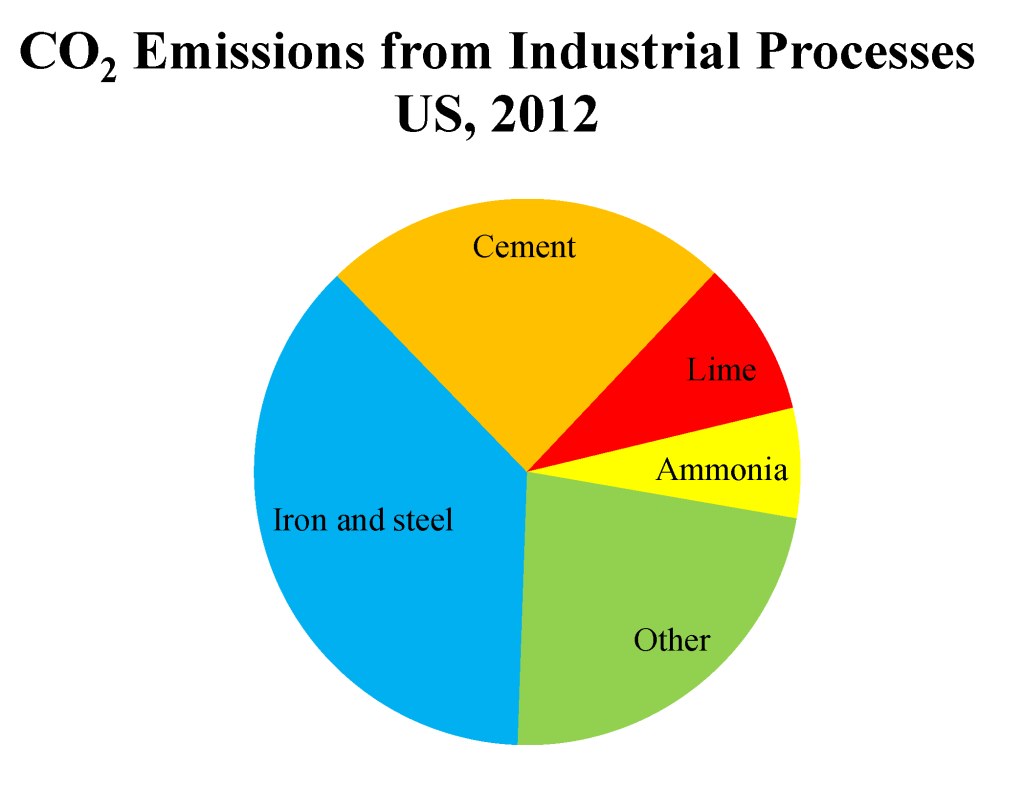When we think CO2, we usually think energy use, e.g. burning oil, coal and natural gas. However, there are quite a few ways that we add carbon to the atmosphere in the course of our daily lives besides simply burning fossil fuels. Non-energy sources were responsible for 16% of total US greenhouse gas emissions in 2012, according to the EPA.

These non-energy emission sources include deforestation, methane from landfills, and the production of cement, steel, or fertilizer. That last category is known as “process-related” emissions, because the CO2 comes from the actual production of a material, rather than the combustion of fuel to produce heat or electricity.
The importance of non-energy emissions is widely overlooked. For example, two engineers from Google wrote a piece last fall for the IEEE. They describe their hope for disruptive technology in electricity generation. And then they say this:
“Similarly, we need competitive energy sources to power industrial facilities, such as fertilizer plants and cement manufacturers. A cement company simply won’t try some new technology to heat its kilns unless it’s going to save money and boost profits.”
This implies that the greatest climate impact from manufacturing of cement comes from direct fossil fuel consumption, which is simply wrong. It doesn’t matter how renewable our energy supply is—the current method of cement production will still emit carbon dioxide, because CO2 is a product of the chemical process itself.
A brief chemistry lesson
To make cement, you start by mining limestone (calcium carbonate). The limestone is heated in a furnace to produce lime (calcium oxide). The other product of this chemical reaction is CO2, which is released from the furnace into the atmosphere.
CaCO3 → CaO + CO2
The lime is combined with other minerals and heated further to make “clinker” (mostly calcium silicate). Clinker is then ground up with other minerals to make cement powder.

When cement is mixed with water, it hardens over time. Chemically, it is now composed of calcium silicate hydrate. If the cement was also mixed with sand and gravel, then the hardened mixture is called concrete.
Energy-intense material
The furnaces that produce lime have to get very hot (1450 °C), and this is accomplished by burning fuel from coal or oil. Obviously, the cement industry has room for improvement in the energy efficiency department. Cement manufacturing in the US contributes a much larger portion of our energy use than the economic output it provides (EIA). The process could be made more environmentally friendly by implementing a method of reaching these high temperatures that is both more efficient and more renewable.
But emissions from the energy used to make cement are still far less than the inherent, process-related emissions. In 2012, cement and lime manufacturing in the US emitted 48 million metric tons of CO2 as a chemical byproduct (EPA), compared to only 15 million metric tons of energy-related emissions (EIA, Annual Energy Outlook 2014).

Globally speaking, the US cement industry is only a small player, producing just 2% of the total 4.2 billion metric tons produced worldwide in 2014 (estimated values from the USGS Commodity Summary [PDF]). By far, the largest contributor to cement emissions is China, which produced 2.5 billion metric tons in 2014, over half of the global total. Cement-related emissions are estimated to be 5% of global CO2 output.
Two ways out
So we’ve learned that the cement industry has a big carbon footprint, and that the majority of its emissions are intrinsically linked to the material, i.e. can’t be erased by fuel switching or any of the methods we usually think of for tackling climate change. What can we do? Two solutions have been proposed:
- Carbon capture and sequestration (CCS). Go ahead and release the carbon from the limestone, but then grab it before it leaves the cement plant and store it underground.
- Low-carbon cement. Some cement manufacturers are trying to use a smaller proportion of clinker in their product, which would mean less carbon released overall. Other companies are hoping to use new types of cement which don’t rely on mining limestone at all.
Neither of these solutions are viable unless there is some incentive for companies to reduce their CO2 output. (For example, CCS is already up and running at offshore processing plants in Norway, where there has been a carbon tax since 1991). Without a price on carbon, it is hard to imagine making a dent in the CO2 emissions that come from making cement. Our appetite for new buildings and bridges shows no sign of slowing, and we’re not going to run out of limestone any time soon.
For a detailed assessment of how to reduce emissions from the cement industry, see the IEA’s 2009 Technology Roadmap: Cement.